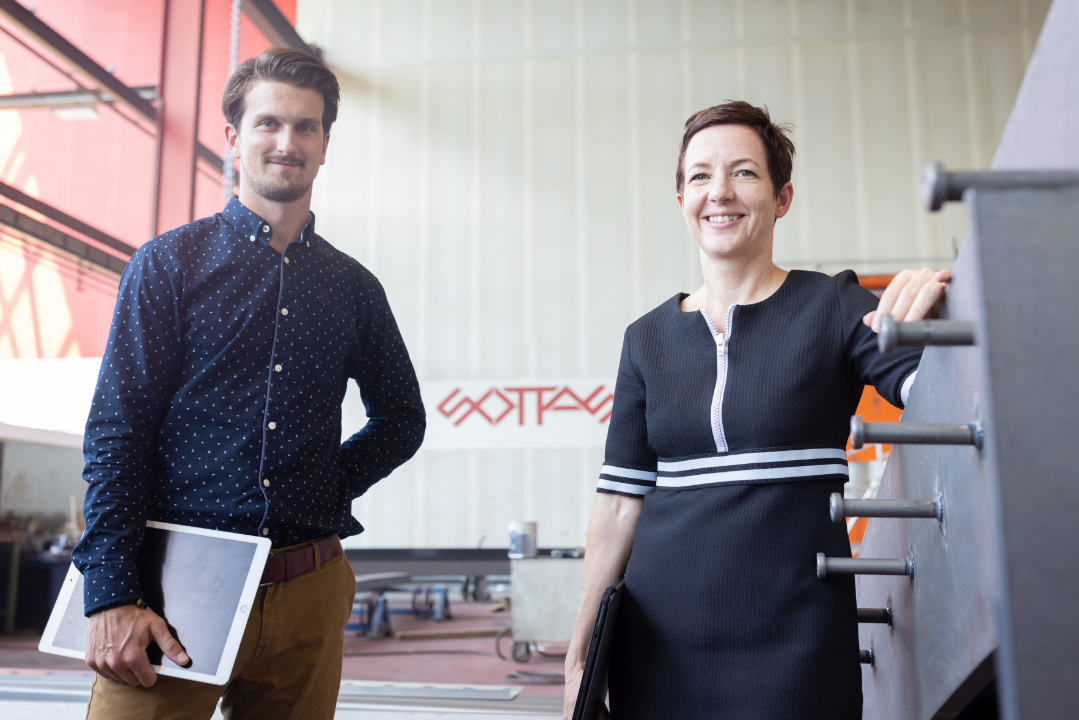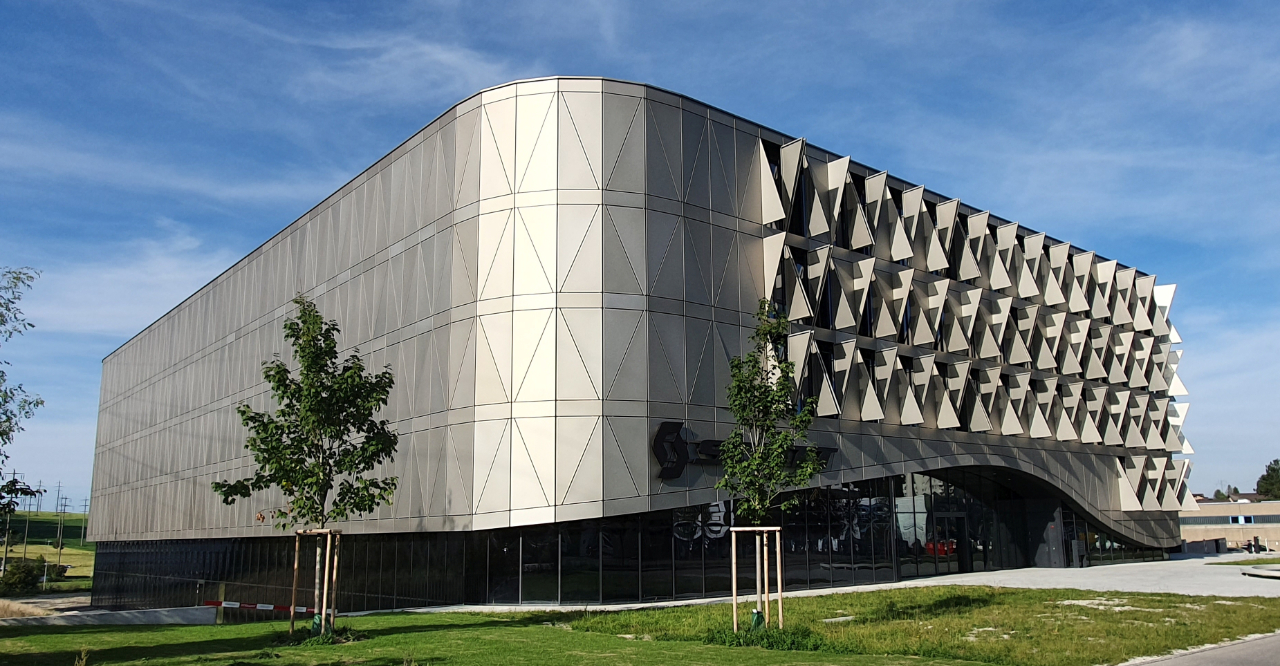“Even the most skeptical members of the team did not want to go back to the old way of working”, notes Laure Sottas Solenghi, member of the Sottas SA board, and Florian Pittet, Connect Manager at the metal construction specialist.

What do the global headquarters of Scott Sports, the Nespresso factory in Romont and the Rolex Learning Center at EPFL have in common? The structural frame or facade elements of all three buildings were made by Sottas SA. This family business boasts not only 40 years of metal construction expertise but also a proven ability to adapt to fast-moving developments and changes in the building industry. Sottas has tackled challenging and unprecedented construction projects with aplomb and never stops innovating. Today, it is a major player in the Swiss market and is expanding its footprint in Europe.
Although structural components and facade elements have become larger and more complex, their production still involves a high degree of craftsmanship. Every building is unique; so too are its components. As board member Laure Sottas Solenghi, and Florian Pittet, connect manager at Sottas, explain, the Fribourg company has embraced Industry 4.0 without sacrificing its commitment to individualized service delivery.
What does digitalization bring to a company like Sottas Constructions?
Laure Sottas Solenghi (LSS): When it comes to designing metal structures, our engineers and technical drawers been using 3D tools for more than 20 years now. Before, they would incorporate all the measurements and dimensions into 2D plans, which were then printed out and sent to their colleagues in the workshop. We have since done away with hard copies. Now, when the workshop team starts assembling the element, they consult the 3D models directly on computers or tablets. Even with new-generation theodolites, it is possible to import 3D models, which also facilitates the measuring and checking processes.
Are there any other benefits besides saving paper?
Florian Pittet (FP): Back in the day, when an assembly worker spotted that a dimension was missing, they would call a technician who would go down to the shop floor, discuss the issue, go back to the office to redraw the part, reprint the plan and hand it over to the assembly worker. It was tedious and time-consuming. Now, the assembly worker simply goes and gets what he needs to finish the job, which makes him feel more self-reliant and involved.
LSS: The computers in the workshop allow us to monitor, in real time, how the work or project is progressing. Previously, everyone had to complete a worksheet. A technician then collected and compiled them to generate an overview of the project status. Today, every single member of our team who is involved in the production process has access to a single chart, which they fill out in real time.
Does robotization feature heavily in your workshops?
FP: We are not involved in mass production. Most of our projects are unique. Robotization allows us to optimize manufacturing flows, as well as simplify and facilitate the work of our team. Co-robotics is interesting, though, because the robots work alongside rather than replace humans. For example, the robots are used to transport loads or perform high-precision operations. This is an area where we still have room for improvement.
Digitalization also generates huge volumes of data. How do you use this information?
FP: Many of our machines provide us with data on things like the duration of operations, the number of parts produced, the material used and productivity rates. We long overlooked this data but now we collect and analyze it. From this information, we are able to identify if our machines are actually adapted to our needs. So, when we have to invest in new equipment, we have tangible data points that help us make informed decisions.
What about your products? Are they also connected?
LSS: We do indeed offer smart facades, which come with sensors. Some types of glass can switch from transparent to opaque depending on the data collected by these sensors. Solutions like these also make maintenance management more efficient: rather than providing these services after a certain amount of time has elapsed, they can be delivered as and when required.
Were these new approaches easy to implement in a company like yours?
LSS: Although Sottas has always been very innovative, it retains a traditional, artisanal feel. It is a sentiment shared by the workforce. Therefore, we had to win them over to the new ways. Having said that, we didn’t simply impose change. We started off with trials, using old computers we reclaimed. After six months, we validated the solution that worked well and installed it in other workstations. Within a year, we had computerized the entire joinery workshop. Even the most skeptical members of the team did not want to go back to the old way of working.
Des tests instructifs
Chez JPF Entreprise Générale SA et JPF-Ducret SA, en charge de la partie technique, on applaudit le résultat final, fruit d’une collaboration fructueuse et vecteur d’expérimentations. « Par exemple, la pose de différents types de dalles et de chapes nous donne l’opportunité de procéder à des tests particulièrement instructifs au niveau statique, thermique ou encore acoustique », note Jacques Pasquier. Le directeur envisage désormais la commercialisation de ce concept de modularité prometteur, répondant à des normes élevées en termes de qualité, de confort et de durabilité.
Transition support
Business digitalization is a core issue for the economy. The Chamber of Commerce and Industry of the Canton of Fribourg (CCIF) launched a collaborative project that brought together local actors, including Sottas SA and the Fribourg School of Engineering and Architecture. Their ideas and input led to the creation of a transition plan for companies. Interested firms go through a connectivity audit, receive support during the transition phase and can take the ‘Digital Manager 4.1’ training course.
This CCIF program takes 16 months. Although much of the training focuses on technology, there are several lean management and green management modules too. Sottas has gone through this process already. As Florian Pittet explains, “Although not all of the topics covered were directly transferable to our company, the training course opened our eyes to the potential of Industry 4.0.”

Scott Sports’ headquarters in Givisiez is one of the iconic buildings built by metal construction specialist Sottas SA.
